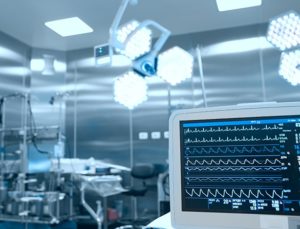The medical device industry is rapidly adopting Internet of Things (IoT) technologies that are dropping costs and improving healthcare outcomes — even in at-home settings. Such IoT systems typically include edge devices (e.g., glucose monitors, ventilators, pacemakers), gateway devices that aggregate edge device data and transmit it to the cloud, and cloud-based systems that analyze device data to draw conclusions, display information, or direct connected devices to take action. Projected returns on such IoT investments are compelling and healthcare companies are investing heavily — McKinsey and Company recently estimated that spending on healthcare IoT solutions will increase to $1 trillion by 2025.

Cardinal Peak has worked with a wide range of medical devices and technologies and is increasingly engaged in IoT initiatives for major healthcare companies. We have built ultrasound systems, surgical device energy generators, Fitbit-like health monitors, medical information memory cards, and RFID tagging systems for configuring and tracking medical devices. In our spare time, we make IoT devices “smart,” connect them to various IoT cloud platforms, and write software to analyze device data for display on web/mobile applications. As we continue our work in the healthcare industry, we are witnessing widespread adoption of IoT technologies in two rapidly evolving areas: 1) patient monitoring systems and 2) hospital medical device systems.
Contents
Patient Monitoring Systems
Integrating IoT features into patient monitoring devices can improve the effectiveness of health services for people with chronic conditions such as diabetes, asthma, cardiac conditions and dementia. While patients with such illnesses can benefit from monitoring to detect and address health problems earlier, healthy individuals in the general population can also benefit from monitoring devices designed to improve healthful behavior patterns related to exercise, diet and stress.
Monitoring patient health can also improve overall healthcare system efficiency by allowing healthcare providers to engage with patients by exception rather than by arbitrarily scheduled visits — patients can see healthcare providers if monitoring systems identify an issue rather than seeing the doctor every 12 months for a checkup.
IoT technologies help medical device manufacturers and system integrators establish wearable device connectivity that offers:
- Monitoring of patients and patient health indicators remotely through both body sensors and through audio/video streaming directly to caregivers
- Transmission of secure data collected by wearable devices to the cloud where it can be analyzed to generate both emergency actions and longer-term healthcare guidance
- Support for emergency notifications to caregivers when health conditions become critical
- Analysis of patient data over time to identify health concerns (e.g., increasing blood pressure, weight, cholesterol, etc.)
- Potential for analysis of aggregated patient data to identify health risk patterns across a population (e.g., rates of heart disease or diabetes in relation to weight, diet, and exercise in California)
While such technologies are evolving at a rapid pace, challenges remain. For example, FDA approval of monitoring devices and the associated cost of such approvals can be prohibitive and can delay time-to-market for innovative new products. Technical and legal challenges related to HIPAA compliance, privacy, and security can slow potentially beneficial systems integration efforts such as those between patient device data and patient medical record-keeping systems.
Hospital Medical Device Systems
For medical device manufacturers, IoT technologies offer a set of tools that can enable remote device access, the ability to interact with other devices or systems in the healthcare ecosystem, and tools for performing “smart” tasks and analysis. Here are some likely benefits:
- Predictive maintenance — system monitors medical device operation for faults and prevents malfunctions rather than responding to them. Remote software/firmware updates allow many faults to be addressed more quickly and cost effectively.
- Initial medical device activation, follow-on feature activation, and support for hospital preferred defaults — medical devices can be distributed with a base set of features activated and premium features de-activated. Remote activation of features drops feature delivery costs and enables hospital-specific feature sets. Hospital and user (e.g., surgeon) preferences can be maintained and applied to device settings.
- Enable devices to send events and notifications to other devices so that devices can collaborate (e.g, ventilator breathing rates moderated by blood oxygen monitors, surgical energy generators moderate surgical device operation).
- Doctor and hospital-specific analytics — device usage may be correlated with surgical outcomes to provide guidance for doctors and hospitals about best usage practices.
In addition to such complexities as regulatory approval agencies and long product development timelines, significant technical factors make the development of hospital medical device systems especially challenging:
- Making old medical devices “smart” can be cost-prohibitive, so advances in device connectivity tend to be gated by new product releases
- Hospitals regulate the types of wireless communications technologies that can be used so connectivity of devices can be more limited or complicated. Often times, devices can transmit or receive cloud data only intermittently
- Even smart medical devices often communicate with outdated or proprietary communications protocols, further complicating the software systems needed to support device connectivity
The world of interconnected medical devices and supporting technologies is evolving quickly and is likely to transform healthcare over the next decade as the types of technologies, products and services outlined above are introduced to the marketplace.
